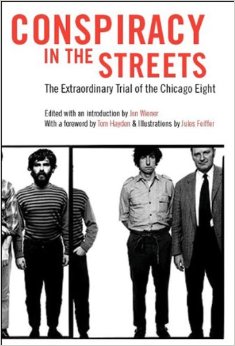Conspiracy in the Streets: The Extraordinary Trial of the Chicago Eight

Judgement Day
Conspiracy in the Streets:
The Extraordinary Trial of the Chicago Eight
Edited by Jon Wiener
New Press, 2006
304 pages; $16.95, paperback
Memory fades, so it’s back to the historical record to explain the great Chicago Conspiracy trial of 1969-70.
Eight antiwar activists were charged by the federal government with conspiracy to organize and incite a riot during the 1968 Democratic National Convention. That was the same convention that saw televised scenes of extreme violence by police against peace demonstrators in the Chicago streets, violence that propelled a shift in the national mood against the Vietnam war.
The government presented the defendants to the public as movement ringleaders. Yet most of them barely knew one another, rather, they were thrown together by the feds’ sketchy and unreliable intelligence on the New Left. The cluelessness of the prosecution, and the sharp differences among the defendants as to just what they were doing there, characterized the trial proceedings from start to finish.
Jon Wiener, a UCLA historian with solid lefty bona fides, collects the crucial details of the trial in Conspiracy in the Streets. The concise volume includes transcript highlights and a useful introduction framing the events in a period of unrest (which many at the time, including this reviewer, mistook for revolution in the making). The results are enlightening, both as a snapshot of a rich historical moment, and as a study of how a bunch of activists from a young, raw, but burgeoning social movement responded to naked state repression.
Thousands of people went to Chicago in August 1968, not to rape and pillage, but to vent frustration over the political direction of both major parties. In the months before the convention, the most prominent opponents of the war, Martin Luther King, Jr. and Robert Kennedy, had been assassinated. The pro-war Vice President Hubert Humphrey had the presidential nomination sewed up. The convention was a big perk for Chicago’s old-time political boss, Mayor Richard J. Daley, who had ordered his police to “shoot to kill” during the ghetto uprising that followed King’s death only four months before.
The August protesters were a mix of student and peace activists and freaks. The activists were rallied by the major antiwar coalition, the National Mobilization Committee. The freaks were hippies, runaways and castaways drawn by the antiwar “Festival of Life” announced by the Yippies, a loose crowd of activists and artists.
When the protesters arrived, they found the local authorities not just uncooperative, but openly hostile. Frustration led to confrontation. The cops, with a green light from the top (and already jolted by the Black rebellion), went wild on live television. It was a bloody rout, but Humphrey, Daley, and police everywhere got the worst of it. The thuggish face of power was exposed, and someone had to be blamed.
The charge that these particular eight men made it all happen was ridiculous, and Nixon’s Justice Department knew it. Their real objective was a show trial in the spirit of the McCarthy/HUAC hearings that had demonized Communists and anyone else tagged as red in thinking or association. But none of the defendants were CPers or even close to the party. Mobilization leaders Tom Hayden and Rennie Davis, Yippies Abbie Hoffman and Jerry Rubin, and local-level activists John Froines and Lee Weiner were all from the student movement. Bobby Seale was a leader of the Black Panther Party who gave one speech at a convention week rally. David Dellinger, also of the Mobilization, was older and a venerable Christian pacifist. The prosecution thus had a hard time making the defendants seem scary, especially with the ugly rep law enforcement had earned in 1968.
Defendants Dellinger, Hoffman and Rubin and attorney William Kunstler wanted to turn the show trial strategy around, using witnesses (including performing musicians) to expose the court as an instrument of repression and a culture of death. Hayden, David, and the other lawyers wanted to focus on the prosecution’s wretched case.
But the one who most tarnished the system was presiding Judge Julius Hoffman. Judge Hoffman (unrelated to Abbie), who was a typical, by-the-book, vaguely liberal Chicago judge, had nothing to gain in further politicizing the trial. Yet from the start he threw away all pretense of impartiality, reacting to the defendants as if he were an English professor forced to discipline a bunch of reform school truants. He became a living caricature of the straight white patriarchy, Elmer Fudd to the Bugs Bunnys of the world.
He turned from silly to treacherous when he decided to muzzle Bobby Seale. The Panthers were then the target of the FBI’s COINTELPRO campaign of murder and terror, and Seale had no reason to find Judge Hoffman’s behavior comical or ironic. When Seal’s lawyer was unavailable due to illness, Judge Hoffman insisted that Seal be represented by the other defendants’ lawyers. Seale argued he was being denied basic rights and made his objections forcefully and insultingly. The judge had Seale restrained and at times battered by court marshals. On October 29, 1969, Seale was dragged out of the courtroom, and was returned gagged and chained to a chair. He remained that way for two days.
A federal judge had used his authority to publicly persecute, violate, beat, and humiliate a Black man in the name of courtroom etiquette. White civil society stood in opposition, nose to nose, with human rights. Seale, to his eternal credit, did not blink. Judge Hoffman, to his eternal shame, never opened his eyes.
Seale’s case was severed, leaving seven defendants. Froines and Weiner were acquitted.
The judge threw the book at the rest (and the lawyers, for contempt of court). All were acquitted on appeal.
An afterward from Hayden extends the historical context to Seattle and Camp Casey. It completes the book, reminding us that, in spite of short memories and burnt bridges, the history recorded here is still our current address.
